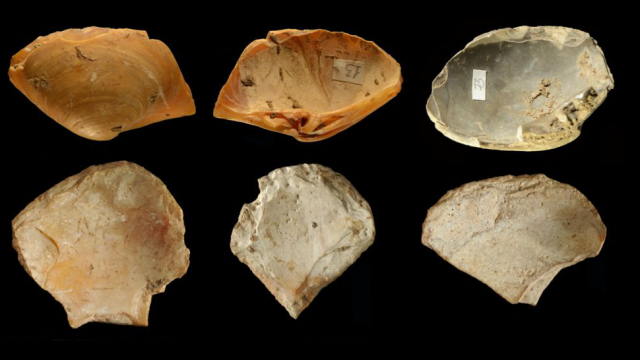New evidence suggests Neanderthals gathered clam shells and volcanic rock from the bottom of the Mediterranean, which they fashioned into tools. The work is yet more evidence that Neanderthals often ventured into the water, and it adds to the body of research showing that they were nothing like the unintelligent, uncoordinated clods they’ve long been portrayed to be.
Researchers have previously uncovered evidence of Neanderthals exploiting marine resources, namely fish. The full extent to which these archaic humans took advantage of the sea, however, is not fully known.
A new paper published in PLOS One offers further evidence that Neanderthals didn’t shy away from the water, showing they gathered clam shells and volcanic rock from a beach in what is now Italy. The authors of the new study, led by Paola Villa from the University of Colorado, say a significant portion of the clam shells were collected as live animals, which required the Neanderthals to wade or even dive in shallow waters. These artefacts date back some 90,000 to 100,000 years to the Middle Paleolithic, predating the arrival of anatomically modern humans to Europe by around 60,000 years.
These arefacts were found at the Grotta dei Moscerini site in Italy, which was once a cave that overlooked the Mediterranean Sea. Found in the 1930s, Grotta dei Moscerini is one of two known Neanderthal sites in Italy, and it underwent extensive excavations after the Second World War. Sadly, the cave is no longer accessible because highway construction work in the 1970s buried the entrance.
Thankfully, the artefacts and fossils pulled from the site, including mollusks, animal teeth, and sediment, allowed scientists to date the site during the early 1990s. For the new study, Villa and her colleagues re-visited some of these artefacts, including 171 modified shells, where are kept at museums in Anagni and Rome.
Close inspections of these clam shells, all belonging to the Mediterranean species Callista chione, suggests they were fashioned into scrapers. Many of these shells were collected from the shore, but a significant portion were gathered directly from the seafloor.
The researchers know this because beached specimens are distinguishable from specimens that were collected as live animals; telltale signs include the degree of shine on the outer valve, the level of preservation as seen on both the internal and external surfaces, traces of encrusting marine organisms, and signs of abrasion on the hinge. This method was developed by Carlo Smriglio, a co-author of the new study and a researcher at the University of Rome.
In an email to Gizmodo, Villa provided further details.
“The outer shells of live animals living in the sea are shiny,” she said, whereas the “beached specimens exposed to the Sun have an opaque and patinated [glossy] surface.” Crusts inside the shell valve left behind by marine organisms “mean the animal was dead,” and the “two valves were opened so the mollusk was dead in the sea and later taken by waves and thrown on the beach,” said Villa. “If encrustations are on the outer shells, it means that they formed when the animal was alive in the sea,” she added.
In total, 40 of the 167 clam shells identified as tools were gathered by Neanderthals from the seafloor, which amounts to nearly 24 per cent.
The same sedimentary layer also yielded volcanic pumice stones, which could have also been used as scraping tools. The authors traced the geographical origin of these pumice stones to erupting volcanoes in the Gulf of Naples, which is located 70 kilometers (43 miles) from Moscerini beach. Strong sea currents likely transported the stones to the Moscerini beach site, according to the paper.
In this case, it’s likely that Neanderthals either waded or dove right into the water to search for and gather clam shells.
These clams “burrow in the sand, but their syphon, which they need for feeding, excreting, and reproducing,” is visible, Villa told Gizmodo. “If you see the syphon, then you know that there is a mollusk and you can use your hand to scoop the sand.” And by putting their heads under water, the Neanderthals would’ve been better able to see what they were doing, she said.
That Neanderthals spent a lot of time underwater is not wholly shocking. Evidence presented in 2019 showed that some Neanderthals had abnormal bony growths in their ear canal, a condition sometimes referred to as swimmer’s ear or surfer’s ear. This is often seen in people who partake in water sports in colder climates.
The new study “confirms that Neanderthals had the broad knowledge of environmental resources generally attributed to modern humans only,” said Villa.
Interestingly, the sedimentary layer containing the clam shells was surprisingly devoid of traditional stone tools. Villa said the Neanderthals may have preferred the clam shells, as they are relatively thin and sharp and easy to re-sharpen, unlike flint tools. Another possibility is that the materials required to build stone tools were scarce and Neanderthals turned to clam shells as an alternative, but Villa doesn’t believe this was the case, saying it was fairly easy to just scoop the shells from the seafloor.
The image of Neanderthals as hulking brutes is now firmly in the rearview mirror. Archaeological research has replaced these outdated notions with a more nuanced picture, in which we can now conjure images of Neanderthals fashioning jewellery from eagle talons, caring for individuals with physical disabilities, playing in the mud as children, and now, free-diving Neanderthals searching for clam shells.
Archaic or not, they were definitely human.
